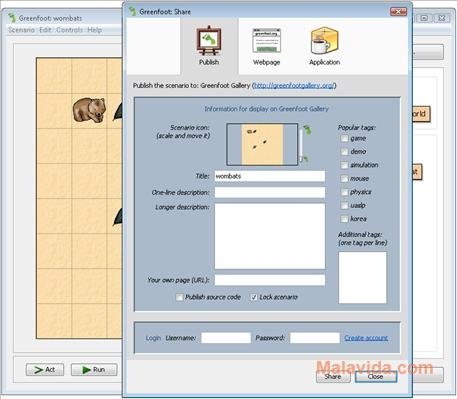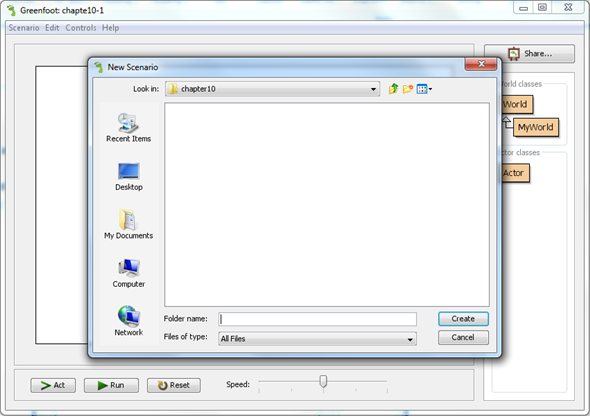
This is important to avoid confusion and distinguish separate bodies of code, or bodies within bodies. chapter 2 We have solutions for your book This problem has been solved: Problem 1E Chapter CH2 Problem 1E Step-by-step solution Step 1 of 5 Program to place a crab into the world Steps to open a scenario: The steps to open little-crab scenario are as follows: Open the Greenfoot application and click on the menu Scenario from the menu bar. How and why should indentation be used in programming? (page 25) Indentation is mainly used to keep track of curly brackets by having individual pairs on separate vertical axes. The answer is simply that I read the documentation. How can a programmer verify brackets match? (page 25) Greenfoot will highlight sets of opening and closing brackets when moused over. How did I know about Greenfoot's GreenfootImage class and the setColor() and. (page 24) An if-statement can prefix a method or statement to allow or prevent its execution depending on whether a specified condition returns true or false. Its easier to figure out tough problems faster using Chegg Study. Methods with the boolean return type return a binary value, typically represented and interpreted as "true" or "false". (page 23) Methods with a void return type do not return anything. How many methods does the Animal class have? (page 22) 5 Explain void return type & boolean return type.

Greenfoot chapter 2 answers how to#
Last but not least, we have started to learn how to make decisions.How do you find what methods are available in Greenfoot? (page 22) Opening the documentation of a class will display the method summary. Documentation gives you a summary of the methods available for a class. We saw inheritance: classes inherit the methods from their superclasses. It’s not a sign of a bad programmer, it’s just a normal part of programming. This is super normal, and will continue to happen as long as you are programming. The action is defined by a method of the object. You might have had some programming errors. Answer method call: an instruction that tells an object to perform an action. We also learned how to find the body of the act method, the place where we will start writing out instructions. We learned how to call methods (like move ()), and with or without parameters. What happens? Explain what you see, then fix it by putting move () back where it was. Write down the numbers and why you think they are good (justify your choice).Ģ.16 Try this: Put the move() statement inside the if statement instead of after it. Be very careful about the opening and closing brackets, you could easily miss one or have too many.Ģ.15 Try this: Use a bunch of different numbers for the turn parameter.
Greenfoot chapter 2 answers code#
You can see that the move() method call is outside of the if statement, so it is going to happen (be executed) no matter if we are near the edge of the world or not.Ģ.14 Try this: Go for it, type in the code you see above and see if the crabs will turn when they reach the edge of the screen.

The body of the method is the two curly brackets of the if statement. The signature of the method is the first line.

Inside this class definition there is a thing called the act method. These words control what the Crab does, and can and cannot do. 1 Which two elements should typically be included in a computer security policy (Choose two. This is a normal (standard) Java class definition. Do that by double clicking the class or choosing the Open editor function from the popup menu of the class.

We will program the crab starting with movement. This is where the program will run) The class diagram The execution controls (the Act, Run and Reset buttons and the speed slider). 2.1 Looking at Code Lets start Greenfoot and open up the PSPGWombats. The world (the largest area covering most of the screen. Remember the hierarchy arrows let you know that crab is an actor.Ĭrab doesn’t do anything because there is no source code to tell it what to do. Chapter 2 Basics of Programming What we did in the last chapter was helpful for. Check all places that you can get information to create methods in Greenfoot A. What does an instance of the World class do Provide the background scenery for the scenario. The best example for the correct way to name a class is A. With the scenario open, you should see the Greenfoot Actor class and the class called Crab. From your Greenfoot lessons, the reset button resets the scenario back to its initial position. Chapter 2/ Greenfoot Term 1 / 8 Method Call Click the card to flip Definition 1 / 8 A method call is an instruction that tells an object to perform an action. View this answer View a sample solution Step 2 of 4 Step 3 of 4 Step 4 of 4 Back to top Corresponding textbook Introduction to Programming with Greenfoot 2nd Edition ISBN-13: 9780134054292 ISBN: 134054296 Authors: Michael Kolling Rent Buy This is an alternate ISBN. For this unit, open the scenario called little-crab.Ģ.1 Try this: Put a crab in the world and press run.


 0 kommentar(er)
0 kommentar(er)
